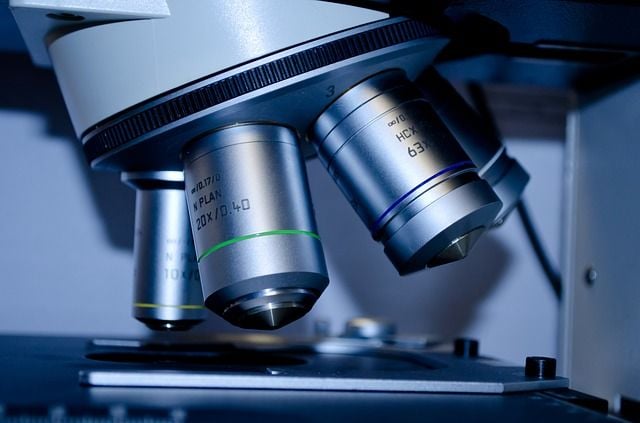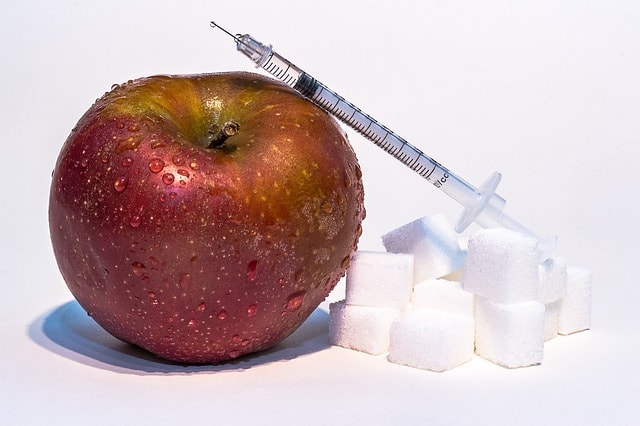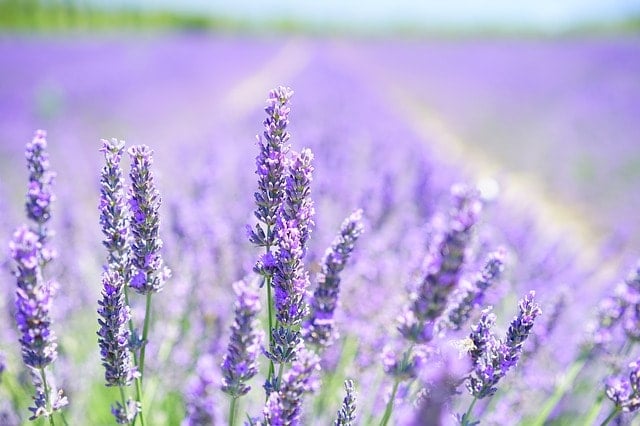Introduction
There are over 250,000 lavender-related products for sale on Amazon. That sure is a whole lot of lavender. These range from essential oils, teas, car fresheners, chocolates, perfumes, and cosmetics to religious crosses.
Lavender is believed to offer a wide range of health and wellness benefits. Purported uses include relief and treatment of anxiety, cancer, depression, insomnia, migraine, and pain, but also anti-ageing and anti-inflammatory properties.
The question that needs to be answered is whether all this hype about lavender is warranted. Or is it more marketing than science?
What Is Lavender Oil?
Lavender was used in ancient Greek and Roman times. The name is believed to derive from the Latin word “lavo,” meaning “to wash,” as steam baths infused with lavender were used for relaxation and brain stimulation in those days. It was also used as a perfume and to mummify bodies in ancient Egypt.
Lavender is a small, branched shrub with characteristic flowers that grows as high as 60 cm. It is native to the Mediterranean basin and Arabian Peninsula but also grows in Australia and the US. Not everyone loves lavender, and it is classified as a weed in parts of Australia and Spain.
Lavender is sold as an essential oil, loose tea, dried flowers, and as a standardized liquid or capsule.
It is used in three main ways: as an aromatherapy, topically, or internally.
It is classified as “likely safe” as a food and “possibly safe” as medicine (1).
Lavender flowers contain a minimum of 1.5% essential oil. Essential lavender oil is extracted from the dried flowers and aerial leaves via steam distillation.
There are two main forms of lavender oil:
- True lavender oil, which is derived from Lavendula angustifolia and contains linalyl acetate, linalool, camphor, beta-ocimene, and cineol.
- Spike lavender oil, which is derived from L. officinalis and contains 35% cineol.
Lavender essential oil should not be ingested, as it is potentially toxic.
Is There Any Research?

There are over 2,000 published studies relating to lavender and over 200 published clinical trials.
To put this into context, this is about one-sixth of the number of studies and clinical trials on Prozac.
At first, this may look like there is relatively little research on lavender, but that is actually not the case. Considering the fact that, overall, there is far less research on natural products, lavender is doing very well in terms of publications.
Though admittedly the cynic in me can’t help but weigh up the popularity of lavender (the 250,000 products on Amazon) to the actual science (2,000 published studies).
Does Lavender Oil Have Antioxidant Properties?
Essential oils often demonstrate antioxidant properties and, therefore, it is biologically plausible that lavender oil could have benefits as an antioxidant agent.
There are no robust clinical trials looking at the antioxidant properties of lavender. However, there is a key paper from Brazil which is often quoted as proof of lavender oil’s antioxidant activity (2).
The researchers used a special assay (DPPH) to measure antioxidant activity in vitro. The experiment was done in triplicate to ensure the reliability of the results. The study found that lavender oil exhibited antioxidant activity in a dose-dependent manner (meaning that antioxidant activity increased with increasing doses of lavender oil).
The authors of the study explain that the DPPH test was just a screening tool to assess for antioxidant properties, which is necessary prior to clinical studies and conclude that “it supports interest in the application of lavender oil as a therapeutic agent.”
Bottom Line
It is too soon to decide whether or not lavender oil has a clinical role as an antioxidant.
Does It Help Treat Diabetes?

Interestingly, diabetes is not usually listed among the umpteen benefits of lavender. Ah, the one that got away. Till now, that is. Recently, some popular bloggers (pseudo bloggers, actually) addressed this oversight and linked lavender oil with diabetes. A really long shot, if you ask me.
There are no clinical trials looking at the effect of lavender on the treatment of diabetes. There are 22 results for the search terms “lavender” and “diabetes.” I have to admit (but don’t tell anyone) that I was looking forward to settling in for the evening to read the 22 articles until I discovered a big problem.
There happens to be a researcher by the name of “Lavender” who studies “diabetes,” but he does not study the plant lavender. When I excluded all of Dr Lavender’s diabetes studies, I was left with just 1 paper (3).
Bitterly disappointed, I followed the trials and tribulations of 48 Tunisian rats aged 15 weeks. The rats were housed five to a cage and had “water and food ad libitum.” All very five-star and humane (or whatever the rat equivalent would be) – until they were injected with lavender, stressed by alloxan therapy to induce diabetes, and sacrificed. The paper was a page-turner for sure.
The study showed that lavender offered some protective effects against alloxan-induced diabetes. What an anti-climax. I am hardly likely to talk to any of my diabetic patients based on this rat massacre.
Bottom Line
There is no human trial evidence to support the role of lavender in diabetes.
Does It Improve Mood and Reduce Stress?
There are a number of interesting studies in this area.
A British study evaluated the effect of oral lavender capsules on responses to anxiety-provoking film clips (4). A total of 97 study subjects were randomized to placebo or lavender capsules. Anxiety measures recorded included mood, heart rate, and heart rate variation. The study participants watched a neutral film clip, an anxiety-provoking film clip, and a light-hearted clip.
The study found that lavender may have anxiolytic effects, but this is limited to conditions of low anxiety and is most evident in female as compared to male study participants.
An Austrian study of 200 patients showed that ambient odors of orange and lavender reduced anxiety and improved mood in patients waiting for dental treatment (5).
A clinical study from nurses based in Norway, Iran and the USA evaluated the effects of reflexology with lavender oil in 90 older women with acute coronary syndromes (25). Needless to mention, this is a very stressful situation and stress is definitely not helpful in this situation. Interestingly, the study found statistically significant benefits of lavender reflexology for feelings of anxiety and depression as well as measurements of analysis of systolic blood pressure, diastolic blood pressure, mean arterial pressure, and heart rate.
A number of studies have evaluated the role of essential oil in agitated behaviors in patients with dementia. To date, the results of the study are inconclusive, with some showing no benefit and others showing modest benefit (6, 7).
Bottom Line
There are no high-quality randomized clinical trials of large numbers of patients for lavender in mood and anxiety. However, numerous smaller studies consistently show that lavender enhances mood and lifts mild anxiety.
Does It Support Brain Function?

There is considerable interest in the potential role of essential oils in supporting brain function and, specifically, improving cognitive function in Alzheimer’s disease. The rationale for this overall interest in essential oils in brain function directly relates to the fact that essential oils have low molecular weights and can penetrate the blood-brain barrier and enter the brain.
Currently, the state of research into the neuroprotective and anti-ageing potential of lavender is in its infancy.
A comprehensive review of the state of research in this field was published by investigators in Pakistan (8). They discussed cholinesterase inhibitory potentials, anti-amyloid effects, superoxide dismutase, and a whole other array of bewildering molecules as possible modes of action of lavender oil in the central nervous system.
The upshot is that lavender oil is a promising but as yet unproven candidate for the support of brain function. The authors concluded that “research needs to be done to evaluate the role of essential oils (including lavender oil) as multi-potent agents” (meaning that they can do more than one thing).
Just this year, researchers from the University of Texas in collaboration with DoTerra Oils reviewed data on essential oils and epilepsy and suggested that lavender may be a candidate for anti-convulsant activity (24). Usually, I would be very sceptical about private sector involvement in research but to their credit, the paper does suggest that some other essential oils eg rosemary and eucalyptus (also sold by DoTerra) may be pro-convulsant.
Bottom Line
Lavender oil shows promise in the support of brain function but is as yet unproven.
Does It Heal Burns and Cuts?
Lavender oil is often used for minor wounds, insect bites, and burns. There are a number of studies looking at lavender oil in healing, but most of these focus on pain or anxiety as opposed to healing per se.
In fact, the main clinical study looking at lavender oil in episiotomy wound care showed no benefit of lavender oil over iodine (9).
A study done in rabbits showed that lavender oil increased the speed of healing pathos mouth ulcers (10).
Theoretically, there are two ways that lavender could help with wounds and burns. Firstly, it has been shown in rat models to accelerate granulation via a molecule called “tissue growth factor” (11). Secondly, like many essential oils, it has some antibacterial properties (12).
Bottom Line
Lavender is commonly used for wounds, and there is biological plausibility but no real clinical trial data to support this.
Does It Promote Healthy Skin and Hair?

Lavender is commonly used in cosmeceuticals. Similar to the data on wounds and burns, there is essentially no clinical trial data on lavender for healthy skin. That being said, it is certainly biologically plausible, as mentioned above.
Hair, on the other hand, is another story. Studies in mice have shown that lavender oil promoted hair growth (13). Lavender is also classified as possibly beneficial for hair loss in the Natural Medicines Comprehensive Database (1).
Interestingly, studies in young hirsute women showed that lavender oil reduces unwanted hair growth (14). This may seem contradictory at first. However, it fits with the general theme that is emerging from lavender research on differential effects of lavender in men and women due to the effects of lavender on sex hormones.
Bottom Line
There is no conclusive scientific data on lavender for skin health, but it is certainly biologically plausible. There are studies suggesting a role for lavender in hair health (assuming that we all agree that hair growth is good in men and not so good in certain places in women).
Does It Relieve Headaches?
A collaboration between German and Iranian investigators evaluated the effect of 15 minutes of inhalation of lavender oil in patients with an established diagnosis of migraine headaches (15). The study looked at 197 migraine headache events in 47 patients.
The study found a statistically significant reduction in headache severity in patients who inhaled lavender oil as compared to control patients who inhaled liquid paraffin. However, it is worth noting that almost 50% of the placebo group (32/68) reported an improvement in their headache, which suggests a significant placebo effect in this patient group.
Bottom Line
Lavender has been shown to be of benefit in migraine headaches, but there may be a significant placebo effect.
Does It Improve Sleep or Help Insomnia?

There are 15 clinical studies looking at the effects of lavender in insomnia. This is interestingly little considering the widespread use of lavender as a sleep aid.
One study was done in Minnesota and looked at 70 Fitbit-wearing college students with self-reported insomnia (16).
The study compared lavender oil patches plus sleep hygiene education versus sleep hygiene education alone. The study found that the lavender and sleep hygiene group had a statistically significant improvement in sleep quality and the feeling of waking refreshed.
Another study looked at 60 healthy nurses who were doing shift work (17). Nurses who inhaled essential oil for 3 minutes and slept near a lavender-infused stone (yes, another product you can buy on Amazon) with a control group.
There was a statistically significant improvement in sleep quality in the lavender intervention arm as compared to the control group.
However, researchers from Iran have just published the results of a study of lavender oil on sleep quality in cardiac patients (25). A total of 150 cardiac pateitns were randomized to either sweet almond oil massage of their hands and feet, lavender oil aromatherapy massage or no massage. They found statistically significant improvements in sleep with massage but found no difference between the sweet almond oil massage versus the lavender massage.
Bottom Line
There is scientific backing to support the role of lavender as a sleep aid.
Does It Relieve Pain?
There are a number of studies looking at the analgesic potential of lavender.
An open crossover study was conducted on 34 hemodialysis patients with arteriovenous fistula (AVF) (18). A direct comparison was made between topically applied lavender oil, water (as placebo), and no intervention (as control) on pain experienced during insertion of large dialysis needles into the fistulae.
The study found that lavender resulted in a statistically significant reduction in the reported intensity of pain. Given the characteristic and easily recognizable scent of lavender, it is understandable that it was difficult to design a randomized, placebo-controlled study. That being said, the current study design of an open crossover study limits the weight that can be given to this study.
A single-blind Iranian study looked at the effect of adding lavender oil to inhaled oxygen in 40 patients post-open heart surgery (19). Inhaling lavender via the oxygen mask had no significant effect on reducing pain scores in these patients.
A Turkish study evaluated the use of lavender oil as non-pharmacological adjutant pain relief in patients with renal colic (stones) (20). The study enrolled 100 patients assigned to standard pain killers (diclofenac) or standard therapy plus lavender oil aromatherapy. The study showed no difference in the pain score at the first time point of 10 minutes but did detect a significantly lower pain score in the diclofenac plus lavender oil group at 30 minutes.
The study was not blinded, which again is understandable from a logistical point of view (lavender has a scent), but this does limit the interpretation of the results. Additionally, the study showed that women responded better than men to the combination of diclofenac plus lavender oil, which again raises questions about the generalizability of the study.
Bottom Line
The science is conflicting about the role of lavender as an analgesic, but it has been shown to provide pain relief in some studies.
Is It a Complementary Cancer Therapy?
Lavender has been shown to be beneficial in the relief of cancer-related symptoms such as pain, anxiety, and depression. However, it has not been shown to have any direct effect on treating cancer at this time.
A Korean study looked at lavender hand massage for 58 patients with terminal cancer (21).
The study assigned 28 patients to hand massage with a blended mixture of lavender, bergamot, and frankincense in sweet almond oil for 5 minutes daily for seven days. The control group received five-minute hand massage with just almond oil alone. There was a statistically significant decrease in pain and depression scores in the intervention arm of the study that included essential oils.
The challenges with this study include the fact that it is impossible to select out the role of lavender oil versus that of bergamot and frankincense. Equally true blinding would be difficult in this study owing to the characteristic aroma of lavender.
Perillyl alcohol is a monoterpene which is isolated from essential lavender oil and is also found in peppermint, spearmint, cherries, and celery seed (22). It has been shown to selectively kill tumor cells and revert tumor cells back to a differentiated pre-cancerous state. Animal studies have shown that it is beneficial in cancers such as pancreatic, breast, and liver. However, preliminary human trials were not clinically effective and were associated with significant gastrointestinal upset.
Bottom Line
Lavender oil has been shown to be helpful in relieving cancer-related symptoms but has not been proven as an anticancer agent.
Is Lavender Oil Safe & Are There Interactions?

Side effects of lavender include skin irritation, joint pains, and headache.
Lavender can also cause skin irritation and photosensitivity.
The most notable side effect of lavender relates to its pro-estrogenic and anti-androgenic profile. Lavender has been noted to cause gynecomastia (breast development) in pre-teen boys (23).
Lavender should be avoided by the following groups of people:
- Pregnant and nursing moms
- People taking sedatives to hypnotic drugs, as lavender may increase their effect
- People on anticoagulation, as it may increase bleeding
- People taking lipid-lowering drugs, as lavender may increase the lipid-lowering effects
- People with hormone-sensitive tumors.
Conclusion
What Is Reasonable to Think About Lavender Oil Based on the Available Evidence?
The science supports the role of lavender as a mild anxiolytic, sleep aid, and migraine reliever. Lavender is also a potential antioxidant and anti-ageing agent but needs to be further evaluated.
In general, it works when symptoms are on the mild end of the scale and is more effective in women.
Two points of clarification:
Am I mad if lavender works for me but it is unproven?
Definitely not. We need to remember that there is no standardization of lavender products used across research studies. As an example, there is a big difference between true and spike lavender oil. Furthermore, the chemical composition of essential oils varies depending on the extraction techniques used, the country of origin, the climate, the soil type, and the age of the plant.
This alone can account for inconclusive studies and variability among studies or in your own personal experiences. I tell my patients that I am delighted if they get better, even if they get better for some reason other than my treatment.
Also, the fact that lavender oil often seems to work best for women could easily be written off as “female madness.” Before you even dare make any jokes, may I point out the fact that lavender has estrogenic and anti-androgen effects, which may well explain the gender differences observed?
And one final comment on "female madness" (it obviously bothers me). One of the most interesting studies that I came across on lavender found beneficial effects on heart rate and blood pressure in both conscious and unconscious patients which adds further weight to the argument that any beneficial effects observed are not all in the mind (27).
Does all this mean that you should not enjoy lavender?
Quite the contrary. I wrote this blog while munching on lavender-laden chocolate and wearing socks from my lavender-scented drawer. As Freud said, “Sometimes a cigar is just a cigar.”
I can justify my lavender fetish by saying, “Sometimes lavender is just lavender.” In other words, I enjoy lavender but am under no illusions that it has antidiabetic or anticancer properties (aka #ConsumerButSmart).

Leave a Reply